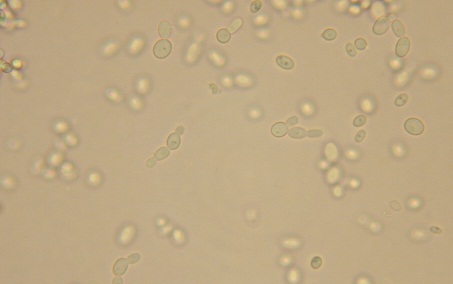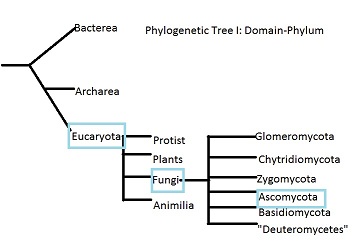Classification
Scientific name: Saccharomyces cerevisiae means sugar fungus of the beer. (Volk 2002)
Common Name: Yeast was a commonly used term and its meaning was known by the majority of society. The roman's named this particular yeast after its use. Since the yeast is used for baking breads, and brewing beers in English we call it Baker's yeast and/or Brewer's yeast.
Taxonomic levels of Saccharomyces cerevisiae
The taxonomic levels of this species domain, kingdom, and phylum have been know for some time and can be easily described. As levels become more specific to the species, the more recent those levels are. Before molecular biology, everything was described by what we can see and how we classify species' relationships. With the help of decoding DNA, scientist have been able to separate species based off their DNA. (Blackwell 2009)
Domain: Eucaryota are defined by their enclosed nucleus with a double DNA strand. They posses multiple organelles specialized to that species out side of the nucleus, such as ribosomes, endoplasmic reticulum, golgi apparatus, ect. (Campbell 2009)
Kindgom: Fungi
are non vascular, heterotrophic species. They have cell walls
similar to that of plants, but differ from plants because they are
made up of chitin. Their
reproduction is very diverse and is how the phylum are classified.
(Campbell 2009)
Phylum: Ascomycota can reproduce asexually or sexually.
They are classified by their internal spores called ascus, which is
the reason why they are commonly known as sac fungus. Sexual
spores are called ascus
and asexual spores are called conidia, which means dust in Greek.
These asexual spores are found externally. Fungus in this phylum can be either
single celled or multicellular. They also have a wide variety
of habitats ranging from marine, to freshwater, to terrestrial.
(Campbell 2009) Another cool
example of ascomycota is
Ergot, to learn more check out its page!
Class: Saccharomycetes are single celled fungi called yeast and don't possess a fruiting body. They feed on sugar. (Malloch 2009)
Order: Saccharomycetales feed on primarily plant sugars.
Family: Saccharomycetaceae are related
based on their DNA sequence.
Genus: Saccharomyces posses both a metabolism pathway and a fermentative pathway in respiration. They are usually very easy to culture and manipulate. (Mycology Guidebook 1974)
Species: Saccharomyces cerevisiae are commonly used in labs and in food products such as breads and beers. (Mycology Guidebook 1974)

Continue reading about its habitat or return to homepage.


